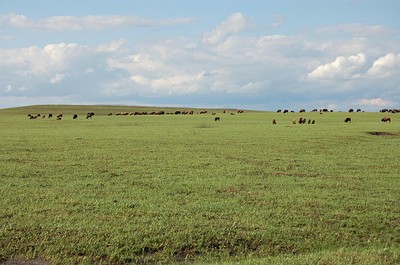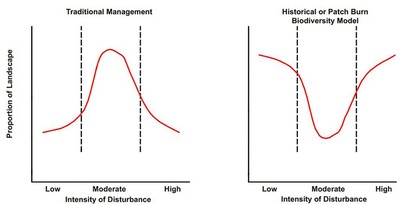Biodiversity & the Fire-Grazing Interaction
Biodiversity is a measure of the relative diversity among organisms present in different ecosystems. To maintain biodiversity in the Great Plains we need to avoid the traditional management for the middle, uniform moderate disturbance (homogeneity) and strive to manage for the entire spectrum of disturbance (heterogeneity) (Figure 2). This means developing a management practice that uses the historic fire-grazing model to manage these ecosystems.
The historical fire-grazing interaction that occurred throughout the Great Plains was a shifting mosaic of disturbances across the landscape that included areas that were burned, grazed, burned and grazed, along with regions that were not disturbed. An area would burn and as it greened-up herbivores of all kinds would concentrate on it. This burned area would become heavily utilized which caused other areas to receive very little grazing pressure. Then at some time during the year another area would burn causing these animals to focus on the most recently burned area. This would allow the previously heavily utilized area to recover for a certain period of time before it would be burned and grazed again. This fire-grazing interaction would repeat itself all across the landscape with timing being determined by climate and re-ignition. This random disturbance pattern created a “messy” landscape which allowed all plant and animal species to exist simultaneously.
Caption: The historical fire-grazing interaction that occurred throughout the Great Plains was a shifting mosaic of disturbances across the landscape that included areas that were burned, grazed, burned and grazed, along with regions that were not disturbed. An area would burn and as it greened-up herbivores of all kinds would concentrate on it. Photo Stephen Winters.
Figure 2: To maintain biodiversity in the Great Plains we need to avoid the traditional management for the middle, uniform moderate disturbance (homogeneity) and strive to manage for the entire spectrum of disturbance (heterogeneity).


